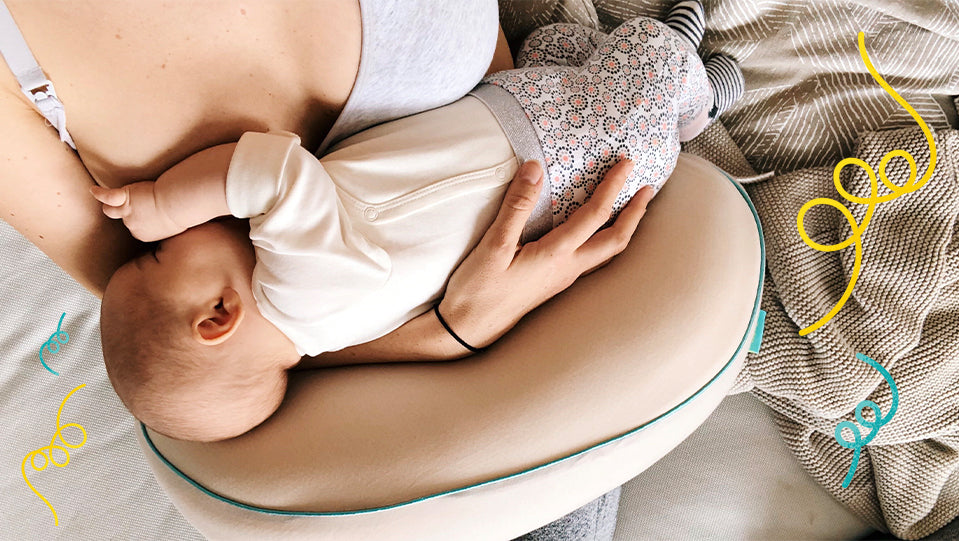If you’ve had shoulder, wrist, back or other muscle pain while breastfeeding, or even bottle feeding, then you’re not alone!
Commonly termed “nursers neck” many new mums experience neck pain when feeding. The long periods of sitting, often in hunched and awkward positions, can also cause lower back, shoulder and wrist pain, making feeding and other daily chores challenging and painful!
The best way to prevent and relieve pain experienced when feeding your baby is to ensure you are adopting a good posture throughout the feed.
Posture Tips for Feeding
Setting Up
- Use a firm supportive chair.
- Place your bottom at the very back of the chair and try and sit on your ‘sitting bones’, rather than with your pelvic tucked under you.
- Use a lumbar roll/ pillow or towel in the small curve of your back to support your natural spinal curves.
- Use an extra pillow or cushion behind you if your chair / sofa is deep.
- Use a small foot stool to bring level of knees up to level of hips or slightly higher to take strain off lower back and hips.
- Use a proper feeding pillow. This will provide support for you and your baby. When you place your baby on a pillow on your lap, it helps to raise the baby up to your breast. When your baby is higher, you won't have to lean forward, so it's more comfortable for your back, neck, and arms. Placing your child at the right height also helps the baby to latch correctly. A proper latch is very important to help establish your breast milk supply and ensure your baby is getting enough milk. It can also prevent some of the common feeding issues that can arise from a poor latch.
Once Latched
- Try and look up and straight ahead of you for periods of time throughout the feed (rather than down at your baby) to take a strain off your neck.
- Rest you head back against the chair if you can– use a small pillow behind your neck if you need extra support.
- Consciously relax your shoulders, hands and wrists and use the feeding pillow instead to support your baby as much as possible.
 |
 |
| Good feeding posture | Bad feeding posture |
Other Top Tips
- Do your feeding stretches daily! These stretches aim to increase mobility through your neck upper back and shoulders and will stretch and relax the muscles that get tight with feeding.
- In the early days try to rest and sleep when the baby sleeps. Holding yourself up tall in a good posture is especially hard when you are exhausted!
- Get active again - try and return to some form of gentle exercise as soon as you can– brisk walks are a great way to mobilise your back, neck and shoulders and will help improve circulation and promote deep breathing. Gentle exercise can also reduce the feeling of tiredness and can improve sleep.
- Restore your core – following pregnancy your core muscles will be weak from being stretched during pregnancy. They are essential for good posture and give much needed support to your spine. It is important that the core exercises you do are suitable for your stage of recovery and are being done correctly. We always recommend women have a postnatal check with a women's health physiotherapist after birth to safely and appropriately start them on an exercise programme for their core.
If you continue to have pain or discomfort when feeding then book in to see a women’s health physio for treatment and further advice.
This blog post was written by Rebecca Dodson and Stacey Law from Leto Women's Health.
Leaders in women’s health, Rebecca Dodson and Stacey Law both trained over 15 years ago as musculoskeletal and sports physios before their passion for working with women led them to specialise in pelvic floor physiotherapy, pre and post-natal exercise, clinical pilates and acupuncture.
Rebecca and Stacey believe that they can make the most impactful difference to lives by both educating clients about their bodies as well as giving them the tools for how to get the most out of them. They bring this approach to all the clients they work with; formulating a tailored assessment and personalised plan that takes the individual into account. They also advocate using exercise as part of the treatment (where appropriate) as that allows them to see how a woman’s bodies responds when her muscles are engaged, and how to best correct any issues that may arise from that.


